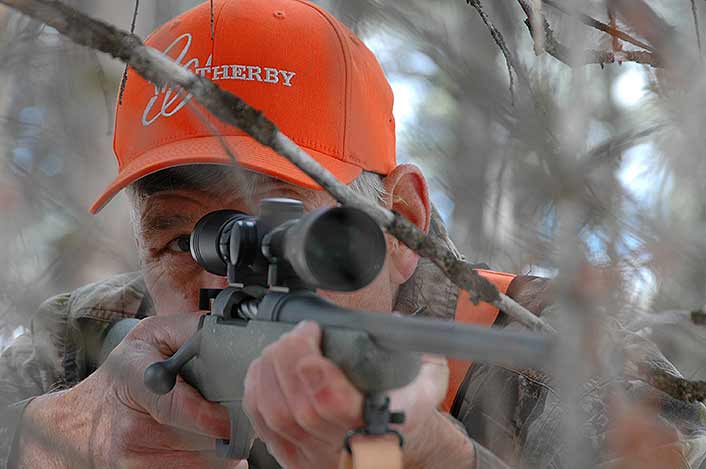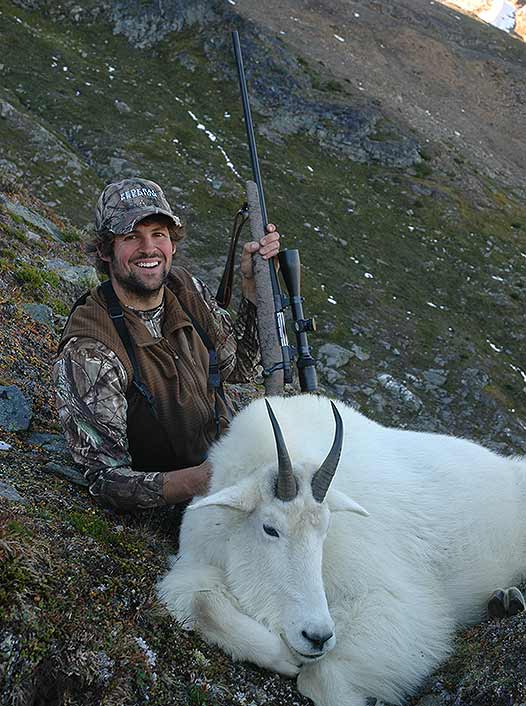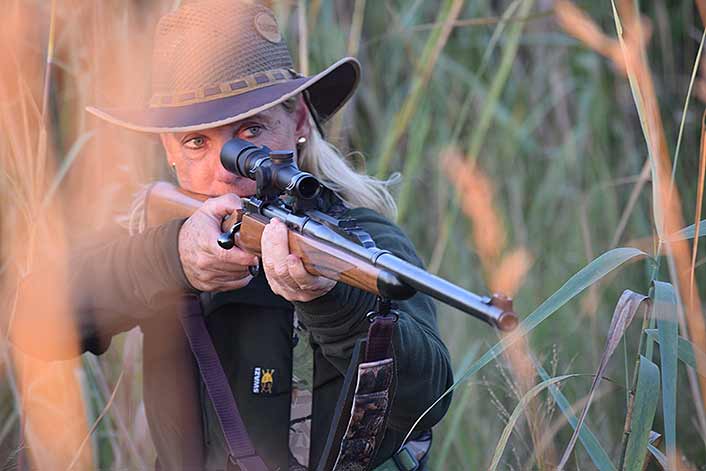Why Hunters Muff Shots
by Wayne van Zwoll
Excuses are legion — but won’t help you shoot better next time. Next time is your chance at redemption.

MEA CULPA. I might as well get that out of the way. I have muffed shots. Many at paper bullseyes and metal silhouettes, some at game. Some were difficult. Those were at targets. When I fire at game, it’s with a measure of confidence. Nothing of substance is lost if a bullet lands in the 8-ring instead of in the middle. A shot that rips the paunch instead of drilling the lungs brings suffering. For that reason, I decline many shots at game, even a few that on target ranges would seem easy.
Those bullets launched at animals should all have connected. Some have not.
The first was meant for a buck nosing about in Michigan wheat stubble one icy November dawn. Under dark clouds and against biting wind, I crept to a fencepost, then, shaking with excitement, pressed my rifle against it. The whitetail looked very small in the K4. It would be a long shot. The reticle quivered above the buck’s shoulder. I tugged the trigger.
The deer kept eating.
It died when, after missing it again, I fired my last bullet. At a loss for a better option I held dead on.

Many hunters overshoot because game appears farther off than it is. In broken country, your eye takes in lots of terrain. But bullets don’t follow ground contours. “Never hold off hair,” Jack Atcheson told me long ago. “If you think an animal is so far that you must aim above it, you’re either wrong or too far away to fire.”
By the same logic, game on the prairie can seem closer than it is, because your eye snares so little earth. Your brain tells you the shot is short because there’s less intervening ground. That’s largely why so many pronghorns have been crippled by bullets to the legs.
Target visibility also influences your perception of distance. Pronghorns are largely white, and in the clear air common on the apron of the Rockies, visible at great range. As there’s little cover, you often see most if not all the body. Bright and big in your scope, that pronghorn looks closer than it is. A swatch of elk or mule deer hide sandwiched by timber across a gaping canyon looks far because it is obscure and small, and there’s so much terrain and vegetation commanding your view.
While distant targets can fool your eye, long shots also magnify errors in shot execution. Add the tug of wind and gravity on your bullet. So even hunters with laser range-finders miss. Conditions — wind, light, your shooting position — matter at any distance, but especially when the target is far off. The longest poke I’ve taken at any game was half again the measure of the next-furthest. Still, my bullet struck less than a hand’s width from where I aimed. Dead-calm air, a front-lit target and my solid, sling-assisted prone position made shooting a reasonable option at yardage ordinarily too long. The clincher: I had used the rifle and ammo extensively on steel targets to 500 yards.

Had an approach been possible, I’d have declined that shot, no matter how certain. Because a kill from afar never pleases me like one earned with a sneak into iron-sight range.
Close shots don’t ensure kills. I’m a member of what must be a small clan who’ve missed game at less than 15 feet. The mule deer was bedded on the nose of a ridge, only its antlers visible from behind. I dropped to the leeward slope and quickly reeled in the yards. Then, crosswind, I bellied toward my prey. Fifty steps from the animal, I could probably have eased to a sit for a shot to the ribs. But full of hubris, I chose to get really close. Slowly my lizard-low approach pulled us together. Alas, I’d failed to see a dip in the ground. A flyrod-length from the buck, my torso was bowed, feet up, belly down. The deer rose. My back had reached its limit of concavity, however. Desperate to boost the muzzle clear of intervening rock, I strained to push the barrel up as I yanked the trigger. The basalt exploded, shards peppering both me and the deer, which shot off that ridge as if riding a rocket.
Few failures afield remain sharper in memory.
Not that I’m alone. I once watched a hunter shoot a brow tine off a bull elk at very short range. Fully exposed, the animal was statue-still while my pal steadied his rifle on sticks. But this was his first elk, and he had his eye on the antlers. Game is often missed — or crippled — because hunters lose focus. Your target is neither the animal nor its antlers. Rather, it is a small place inside the animal, where it lives.
“The young man nervously raised his rifle and fired …. Instantly the buffalo wheeled and charged us at terrible speed …. With admirable coolness, Fay [fired twice, then] threw herself into her lover’s arms. With the two of them locked in a close embrace on the narrow trail, I couldn’t get around the idiots to shoot. The bull was almost on us [when] I managed to force the barrel of my [.475 between them]. The bull came crashing down, throwing foam and blood over Fay’s trousers ….”

John A. Hunter’s tales of his early-20th-century adventures in East Africa fanned my safari-lust. A crack shot, the intrepid Scot showed his skill as a PH after a career as an ivory hunter and shooting for the government. His accounts were not of hits at four-digit yardage, but of fast offhand action, heavy bullets driving, at rock-throwing range, toward mountains of muscle and bone barreling through thickets.
Shooting dangerous game up close makes sense. The shorter the shot, the more likely you’ll hit where you wish. The peril of waiting, of course, is the risk of a malfunction. Inside 15 steps, you’re not only out of time to reload, but face daunting shot angles, a kaleidoscope of motion. “I should have fired sooner,” Don told me after a brush with an elephant. “But I didn’t want to kill that bull.” At six steps, the animal tucked its trunk and came. At two paces, the 9.3×62 Norma solid destroyed its brain. Momentum carried the elephant forward, and as Don leaped aside, the falling beast’s trunk broke his arm.
That episode in memory, Don took a client hunting for a lion. Big tracks led them to a fine male. Smoke from the client’s black-powder load in his Holland 10-bore erased the lion’s departure. But as the white cloud dissipated, a lioness saw the hunters and charged, low and lightning-quick. Again, Don’s shot came at the last instant, his bullet smashing the animal’s spine between the shoulders. Dead in mid-air, the lioness cart-wheeled. “Yes,” he reflected, “firing sooner would seem the better option. But sometimes the window is very, very small. Sending a bullet as soon as the rifle hits your shoulder can be too late. A lion can reach you faster than you can say, ‘Kitty’s coming! Shoot low!’”
Even if your life never hinges on a quick shot, precision has a price. A deer may pause for only a second at cover’s edge. Deliberate aim can cost you the chance.
Quick instinctive shooting is a skill (albeit the truly gifted make it seem like an art). As with other skills, you cultivate it with practice. But these days, hunters are shooting less from unsupported positions and increasingly from the bench. Ever-more-sophisticated rifles, optics and loads developed to hit targets far away are ill-suited to catch-as-catch-can marksmanship. They reward instead time-gobbling math that reduces the shot to a science. Wind, range, even a bullet’s ballistic coefficient figure in. The shot is not so much executed as engineered. Time stands still in this pursuit of precision.

But hunting is exciting largely because you cannot predict how your next chance will come! My first deer rifle, a battle-worn SMLE I re-stocked and fitted with Williams open sights, was by no current measure accurate. But it killed a couple of deer I’d likely not have taken with a scoped rifle, let alone one of the “long-range” models popular now. A red fox that scooted from underfoot one winter day tumbled to that old .303 before I realized I’d cheeked and fired it. A whitetail buck bounced from thick pines just a few feet away dropped in two jumps. Again, I’d fired as if the rifle were a shotgun. As if shooting grouse.
Even when you have plenty of time, you’re ill-advised to wait for the sight to hang in the center. If it visits the middle, it won’t stay long. The longer you aim, the wearier you become. The accuracy you expect influences the speed of your shot. No one holds a rifle still; the best you can hope for is acceptable wobble. You determine the speed and amplitude of sight movement. Demanding too much precision it to court a miss! When breathless on a windy hill, you must accept more motion than when conditions favor you. Insisting on a perfect sight picture can yield the same result as firing before your sight finds its mark.
My first shooting coach, Earl, told me: “Don’t over-think. As soon as you feel a good shot, let it go. Don’t analyze it; don’t tell yourself it’s too good to be true. Just turn it loose.” Sound advice.
“A bullet from my right barrel hit him above the brisket. He never flinched and came on …. The [next] shot hit him fairly below the ear, and he went down. At the same moment [another rhino] tore past me and I saw my scout hanging on his horns …. I waited [an instant] then fired for the rhino’s shoulder. The animal dropped and the boy shot off his head like a rider whose horse has refused at a jump ….“
As John Hunter knew, there’s a time to aim, and a time to fire.
Before bullets traveled at Mach 3, exhibition shooters married accuracy and speed in eye-popping routines. Early among them: Phoebe Ann Moses, born in an Ohio cabin in 1860. Hunting to help feed her family, she showed extraordinary talent with a .22 by hitting quail on the wing with a .22. At age 15 she soundly beat visiting marksman Frank Butler at a local rifle match. A year later she was Frank’s wife, and shooting for his traveling show. Soon they joined Buffalo Bill’s Wild West Show, she as Annie Oakley. Aiming in a mirror, Annie fired over her shoulder to burst glass balls Frank tossed. Rattling 25 shots in 25 seconds from a .22 repeater, she could make one ragged hole in the center of a playing card. A colleague, Johnny Baker, tried for 17 years to outshoot Annie. “She wouldn’t throw a match,” he said. “You had to beat her, and she wasn’t beatable.”
Ad Topperwein had the magic too. Born in 1869 in Texas, he showed an artistic eye early on and was first employed as a cartoonist. Ad had little interest in hunting but enjoyed firing at airborne targets. In exhibitions he found tossed wooden blocks and clay targets easy prey for his .22 rifles, and combined his talents to sketch Indian heads with bullets fired into sheets of tin, a shot a second. In 1907 he recorded 72,491 hits on 72,500 thrown blocks 2¼ inches on a side. That tally, shot with Winchester Model 1903s, stood unmatched for half a century. Remington’s remarkable Tom Frye finally beat it using Nylon 66s, at the autoloader’s debut. He fired at 100,010 blocks and missed just six!
That era passed during my youth, as Winchester’s Herb Parsons wowed pie-eyed fans. A table of assorted firearms within reach, Herb would start talking and tossing things aloft, blowing them apart with whatever rifle or shotgun came to hand. He’d pulp oranges with a .30-30, then snatch up a .348 to “chop salad.” Grabbing a Winchester .351, he’d fire the auto’s 10 shots from the hip, shattering 10 clay targets standing on edge. “They’re not hard to hit, folks,” he’d laugh, deftly switching rifles, “just easy to miss!” Chattering on as fast as he shot, Herb would bend over, toss a handful of eggs between his legs, whirl and break them all with quick shotgun blasts as they fell. He’d milk seven rounds from a Model 12 so fast the bursts came as rolling thunder, leaving dust floating where with one hand he’d lofted as many clay disks.
Herb hunted with Hollywood stars of his day — Andy Devine, Clark Gable, Roy Rogers. He did the stunt shooting for the movie “Winchester ’73,” starring Jimmy Stewart. A champion shotgunner, Herb loved waterfowling — for which he used Winchester’s .410 Model 42. On one hunt he dropped ducks so fast, his partner fired not a shot until at last Herb unloaded his .410. “Your turn,” he grinned. On July 19, 1959, Herb Parsons died of a heart attack, following surgery. He was 51. A hunting guide observed: “That man was a machine. He never missed.”
Well, he did. Everyone who has shot has missed — even the late Tom Knapp, Benelli’s sharp-eyed exhibition shooter, who could toss a stack of nine clays and powder them all before any hit the ground. I once asked Tom if he used an open choke, to ensure hits. “No,” he said. “Patterns must be small so each hits only one target. In fact, I often focus on a section of a target to prevent hitting another close by.” Tom told me that with a .22 he had hit a tossed golf ball thrice before it landed, clipping it low to keep it aloft. He once smashed 13 tossed aspirins in a row
I asked what, besides extraordinary hand-eye coordination, made such aerial shooting possible. He shrugged. “Standing hip-deep in spent shotshells every day doesn’t hurt.”
Wayne van Zwoll has published 16 books and roughly 3,000 magazine articles on firearms and hunting. Five of his most popular books are: Shooter’s Bible Guide to Rifle Ballistics ($20), Shooter’s Bible Guide to Handloading ($20), Mastering Mule Deer ($25), Mastering the Art of Long-Range Shooting ($30) and Gun Digest Shooter’s Guide to Rifles ($20). Limited numbers are available, autographed, from Wayne at 2610 Highland Drive, Bridgeport WA 98813. Please add $4 shipping.
Stay Connected
- Got a Break in the Montana Missouri Breaks
- It Took Six Days but We Finally Slipped One Past the Bears and Wolves
- No Mule Deer This Fall – Whitetail TOAD!
- An Accounting of Four Idaho Bulls (Elk)
- Arizona Deer Hunt 2019: Good Times with Great Guys
- Caught a Hornady 143 ELDX Last Night
- Cookie’s 2019 Mule Deer Photo Run
- Let’s See Some Really Big Deer
- Alaskan Moose Hunt Success!
- Take a Mauser Hunting: An Important Message From The Mauser Rescue Society!
- Welcome 16 Gauge Reloaders! Check In Here.
- Off-Hand Rifle Shooting – EXPERT Advice
- BOWHUNTING: A Wide One!

